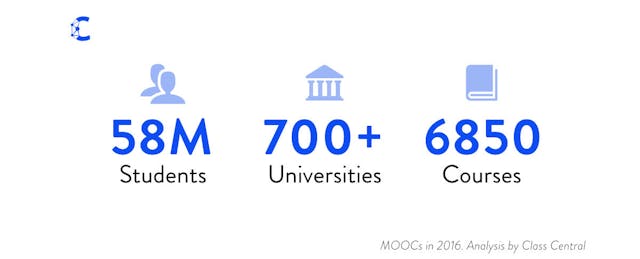The modern massive open online course movement, which began when the first “MOOCs” were offered by Stanford professors in late 2011, is now half a decade old. In that time, MOOC providers have raised over $400 million and now employ more than a thousand staff.
The spotlight on these companies have since dimmed, yet they continue to expand their footprint. In 2016, 23 million people registered for a course for the first time ever, according to data collected by Class Central. A quarter of them signed up through regional MOOC providers such as XuetangX (initiated by Tsinghua University and the Ministry of Education in China) and Miríada X (a joint initiative of Telefónica Educación Digital and Banco Santander through Universia in Latin America). The total of number of students who signed up for at least one course is 58 million, up from an estimated 35 million last year.
By registration count, Coursera is still by far the largest MOOC provider in the world with over 23 million learners. Of the top five providers, only XuetangX is an non-English platform:
- Coursera - 23 million
- edX - 10 million
- XuetangX - 6 million
- FutureLearn - 5.3 million
- Udacity - 4 million
In 2016, 2,600 new courses were announced (up from 1,800 last year), taking the total number of MOOCs to 6,850 from over 700 universities. Even Oxford University, one of the oldest universities in the world, jumped on the MOOC train.

Unlike previous years, no major venture funding rounds went to MOOC companies in 2016. That means for many providers, monetization became a priority. Some of the features that were previously available for free—certificates, graded assignments and content—are no longer so. All the major providers already have or plan to launch courses that are paid only.
And it seems to be working. The “Big Three” MOOC providers—Coursera, Udacity, edX— combined have potentially made around $100 million in 2016.

Top 2016 Trends
MOOCs No Longer Massive: MOOCs are gradually being transformed from virtual classrooms to a Netflix-like experience. Many courses are no longer offered just once or twice a year, but rather are now available as a self-paced, sign up whenever you want experience Coursera courses are now offered regularly throughout the year, with new sessions starting automatically on a bi-weekly or monthly basis.

This switch has led to a significant increase in the number of courses students can register for and start almost immediately. Previously, students were all piled into one giant session for courses that were only offered infrequently.
This means that instead of tens of thousands of people learning together, many students are learning at their own pace and in much smaller cohorts. Remarkably, forum activity for many courses is almost non-existent. At one point Coursera boasted about an average forum response time of 22 minutes; that’s no longer the case.
College Credit, Credentials, and Degrees: Will students pay to prove that they completed a course? That seems to be the bet among MOOC providers, which now offer more than 250 credentials. (That amounts to roughly 750 courses, given that given that each credential usually consists of at least three courses.)

Here is a quick overview of what’s happened in 2016. The list is in no particular order.
- EdX expanded its MicroMasters credential to fourteen different universities.
- FutureLearn announced six postgraduate degrees from Deakin University and launched a new credential called FutureLearn Programs.
- Kadenze launched its own credential system, called Kadenze Programs.
- Coursera expanded its Specializations to 160 and has also announced a second Master’s program with the University of Illinois.
- Almost 4,000 students are currently enrolled in Georgia Tech’s and Udacity’s Online Masters in Computer Science program.
Regional MOOC Providers Pick Up Steam: Around 25 percent of the new MOOC learners were attracted by regional providers that offer courses in languages other than English. Providers like XuetangX (China), Miríada X (Latin America) boast millions of learners, while France Université Numérique, and Edraak (Middle East and North Africa) are on the brink of crossing the one-million student mark. This year also marked the launch of SWAYAM, the official MOOC platform of India, and EduOpen, a MOOC platform funded by the Italian government.
Paid Only Courses: In June, Coursera piloted a new format where all the course materials, including the videos, were behind a paywall. Coursera has added several paid-only courses since then. The move isn’t new; edX has been running paid courses under what it calls “Professional Education” courses, since 2014.FutureLearn also announced their intention to launch paid only-courses as part of six postgraduate degrees from Deakin University. The degrees will include free sample courses, but a majority of the courses in the degree sequence will be paid.
Decreasing Number of Standalone Courses: For MOOC providers that have launched their own credentials (i.e. specializations, Nanodegrees, Xseries) a majority of the new paid courses are a part of these credentials. In some cases, some of the older courses have been split into credentials. Coursera co-founder Daphne Koller’s MOOC on Probabilistic Graphical Models has now been split into three courses, and is now a Specialization in its own right.
A Push Towards Business to Business (B2B): Will businesses pay? This year Coursera announced Coursera for Business. Udacity, which works directly with many technology companies to create its Nanodegrees, also has a product targeted towards corporate training. FutureLearn has a workplace learning product too, with dedicated landing pages for certain verticals like healthcare and schools.

Subjects
As with last year, courses in Business and Technology (Computer Science, Data Science, Programming) form a big chunk of the courses that have been announced so far. Together they make up 40 percent of all new courses added this year. This concentration should come as no surprise, given that the paid certificates offered by many MOOC providers focus on business and technology fields.
Providers
With more than 1,700 active courses, Coursera still boasts the biggest menu of offerings (even after shutting down hundreds of courses. EdX, with 1300 courses, comes second, followed by FutureLearn and its 480 courses.
Outside the U.S., Miríada X, based in Latin America, offers 350 courses in Spanish. In China, XuetangX has more than 300 courses available in the Chinese language.
Highest Rated Courses
Around 2,600 courses were offered for the first time in 2016. After analyzing more than 8,000 reviews written by Class Central users, we were able to rank the courses (by the Bayesian average of their ratings) to create this list of the top-rated free online courses for 2016.
- Coding in your Classroom, Now! from University of Urbino via EMMA
- Tsinghua Chinese: Start Talking with 1.3 Billion People from Tsinghua University via edX
- The Nature of Code from Processing Foundation via Kadenze
- Introduction to Agent-based Modeling from Santa Fe Institute via Complexity Explorer
- The 3D Printing Revolution from University of Illinois at Urbana-Champaign via Coursera
- Becoming a changemaker: Introduction to Social Innovation from University of Cape Town via Coursera
- Preparing to Manage Human Resources from University of Minnesota via Coursera
- Creative Applications of Deep Learning with TensorFlow via Kadenze
- Teaching for Change: An African Philosophical Approach from Stellenbosch University via FutureLearn
- Stanford Introduction to Food and Health from Stanford University via Coursera
Top Searches
Class Central users ran over 270,000 searches using 70,000 search terms. These top 25 search keywords (in order) account for 12 percent of all searches: python, java, machine learning, writing, english, statistics, data science, image processing, c, excel, psychology, big data, spanish, marketing, french, accounting, project management, finance, android, music, javascript, sql, law, photography, german.
Top Universities
We used the course ratings of a course to represent its university, and then we took a Bayesian average. We filtered out universities with less than 5 courses or less than 50 ratings.
- Santa Fe Institute
- University of Cape Town
- Vanderbilt University
- University of Michigan
- University of Groningen
- Duke University
- Leiden University
- Massachusetts Institute of Technology
- Harvard University
- Yale University
2016: Monetization over Massiveness
When I did my first MOOC back in Oct. 2011, the videos, assignments, and certificates were free. Now, many certificates are no longer free. In case of many Coursera courses, even the graded assignments sit behind a paywall.
The range of features and experiences that were once free have dramatically shrunk over the last couple years, raising the question of how “open” MOOCs truly are. Taking the course simultaneously with thousands of learners is no longer a selling point of MOOCs (from a course providers perspective). There’s been a decisive shift to focus on “professional” learners who are taking these courses for career-related outcomes, over the dabblers and lifelong learners who take courses just for curiosity’s sake.
In 2017, we will see further doubling down of MOOC providers on this target audience with more credentials and content related to high demand skills in business and technology. We also see MOOC providers will also try to crack the lucrative corporate learning market.


